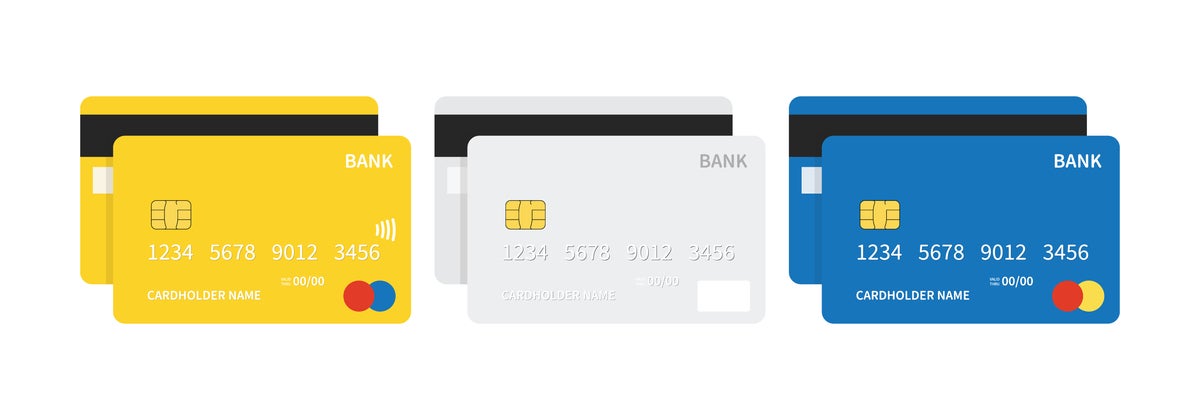What is a Credit Card and How Does it Work? In this article we cover:
- What is a credit card?
- What is a credit limit on a card?
- How does a credit card’s billing period and interest work?
- Using a credit card: the pros
- Using a credit card: the cons
- Tips to best manage a credit card
- What credit card options are there?
- What’s the difference between Visa and MasterCard?

What is a credit card?
A credit card is a card issued by a financial institution, typically a bank, that allows the cardholder to borrow and make purchases on credit. This means any money spent on a credit card is borrowed and must be paid back. This differs from a debit card, which removes money directly from a linked account.
What is a credit limit on a card?
Credit cards come with a credit limit. This is how much can be borrowed, or spent, on the card. Once the limit is reached, the card can no longer be used to make purchases until the amount owed is reduced.
For example, if the credit card limit is $2000, you can’t spend over $2000 on the card, unless you repay some of the debt. If you hit your $2000 limit, then pay off $500, you’ll have access to another $500 of credit.
This is why the official term for a credit card is a revolving line of credit. Because unlike a loan that provides you with a one-off lump sum, a credit card allows you to continuously borrow money. Once you pay the borrowed money back, you can spend again. As long as your card isn’t maxed out at its limit, you have access to credit.
The limit on the card is set by its issuer, and is set according to your income and credit history. You can, however, at any time request the limit on your card to be raised or lowered.
It’s important to note that the higher the limit on your credit card the more your borrowing power will be curtailed. For even if you never hit your card’s limit, it’s regarded as possible debt by lenders. So if you’re a prospective home buyer in the market for a mortgage, it’s a good idea to keep your credit card limit as low as possible.
How does a credit card’s billing period and interest work?
Credit card bills cover roughly four-week periods, based on when the card was first issued. The bill covers all the purchases made within the four-week period, and gives you extra time to repay all or some of the debt.
This is know as the interest-free period. A standard interest-free period on many cards is 55 days.
For example, if a card has a 55-day interest free period, and your latest bill covers all purchases made from November 1 to November 30, you will have until December 25th to pay off some or all of your debt: 55 days from November 1.
If you pay off your bill in full, you incur no interest on your purchases. However, if you only pay part of your bill, any debt that remains will accrue interest from the date it was incurred. This outstanding balance will then appear on your next statement, having earned even more interest.
Note that if you fail to make the monthly minimum repayment shown on your bill (around 3% of total debt) penalty fees and higher interest rates could be charged to your account, compounding your debt further.

Compare Credit Cards with Canstar
If you’re currently comparing credit cards, the comparison table below displays some of the low-rate credit cards currently available on Canstar’s database for Kiwis looking to spend around $2000 per month (some may have links to providers’ websites). The products are sorted by Star Rating (highest to lowest), followed by provider name (alphabetical). Use Canstar’s credit card comparison selector to view a wider range of credit cards. Canstar may earn a fee for referrals.
Using a credit card: the pros
Credit cards can be handy tool to have in your financial tool box and, if used wisely, can even make you money. By using a credit card you can:
Make the most of your spending with rewards
Some credit cards offer reward programs, such as Airpoints or cashbacks. This means every time you spend you get rewarded. Rewards cards tend to come with higher fees and rates than standard cards, so are not ideal if you don’t clear your balance each month.
However, if you pay every credit card bill in full, rewards cards are a great way to receive bonus cash and rewards.
Smooth out cash flow
We’ve all been a little low on funds in the lead-up to payday. It happens. Unfortunately, expenses don’t care about what day your paycheck lands in your account. Because of the long interest-free periods offered on some credit cards, they can be a great way to smooth out your cash flow. Use your credit card to cover expenses now, and clear your debts when your salary comes in. Credit cards are the original buy-now-pay-later!
Cover unexpected costs
Sometimes things happen, and bills arrive that we just can’t afford. In these instances, a credit card can be a real lifesaver. Low interest rate credit cards offer instant access to credit at rates comparable to personal loans. In a dire situation when funds are scarce, a low rate card can offer the breathing space to allow you to get back on your feet financially.
Added security and safety
Many credit cards come with added insurance extras, providing cover for fraud, car rentals or theft. Buying online with a credit card is also generally a more secure alternative to using a debit card, as online credit card purchases are usually covered by a form of fraud protection.
Plus if hackers do get access to your card, they only have access to your credit limit, not your bank account. Credit card lenders also actively look for suspicious fraudulent transactions, and you can easily query transactions not made by you and have them reversed.

Using a credit card: the cons
When used carefully, as we’ve pointed out, credit cards are a handy tool. However, there are risks involved if used rashly:
Temptation
Many people rack up debts they simply can’t afford on credit cards. If you are a shopaholic who can’t control your spending or budget, then a credit card might be a temptation you need to avoid.
Multiple cards
Having multiple credit cards isn’t inherently bad. It can make sense to have a rewards focused card for your everyday spending, plus a low-interest rate card for any big or unexpected expenses. But owning more than one card can be dangerous if instead of paying off your debt you continually switch your debt between the two. Or, you simply max out multiple cards instead of just one. Ultimately, more cards can equal more debt.
Interest & fees
Credit cards offer instant and easy access to credit. And this comes at a cost. The interest rates on most non low-rate cards is around 20% per annum, which is a lot higher than most personal loan rates for those with good credit.
Of course, if you pay off your balance each month, you’ll not pay interest. But you still might have to pay a fee. Typically annual card fees range between $25 to upwards of $500 for premium credit cards, depending on the features and benefits on offer.
There are low fee and no fee cards available, but these tend to charge higher interest rates as a consequence. Some cards may charge zero fees for the entire life of the card. Others might have a specific fee-free period, say for one year, or as long as you meet certain spending criteria.
Just be aware that if the card you choose has no annual fee, there are other fees you’ll need to watch out for, such as:
- Late payment fees
- Foreign exchange fees
- Replacement card fees
- ATM cash advance fees
- Additional cardholder fees
Tips to best manage a credit card
Some helpful credit card dos and don’ts are:
Do
- Always try to repay the full amount to avoid interest. If you can’t pay it all off, pay as much as you can (not just the minimum requirement). Credit card interest is a killer, so every dollar helps
- Check your statements. Make sure there are no suspicious charges, keep an eye out for any changes to your terms and agreements, and look at your expected interest costs. Viewing everything laid out is a good way to see where your money is going and to help plan repayments. Or, just a good way to shock you into changing your spending habits
- Know your repayment days. Forgetting a payment is a silly mistake that can cost you dearly
- Make the most of a balance transfer if you feel your debt is growing out of control
- Know when to stop. Cut up the card if need be!
Don’t
- Max out your card. Spending up to your limit makes it harder to repay your debt and increases your interest costs. It’s also bad for your credit score. Lenders check your credit utilisation ratio (the % of your limit you are currently using) and most agree anything above 50% will hurt your credit score
- Choose the wrong credit card for your needs. If you can’t afford to pay off your balance each month, make sure you have a low interest rate card. If you don’t fly, what are you doing with an Airpoints card?
- Forget about other costs. Annual fees other costs can add up. It’s important to keep these in mind
- Pay the bare minimum. The minimum repayment amount barely puts a dent in the principal. By paying the minimum you are extending your repayments for a long time and incurring interest that can cost you much more than your original debt
→Related article: How to Keep on Top of Your Credit Card
What credit card options are there?
The four main types of credit cards are:
- Low Rate: for those seeking a credit card with a low interest rate and flexible repayment conditions
- Low Fee: for those seeking a card with low ongoing fees and who may want to access some premium card facilities
- Rewards: for those seeking a card that gives them the optimal return on their everyday spending
- Flight Rewards: for those who want to redeem points for flights

What’s the difference between Visa and MasterCard?
The short answer is, there is no difference.
Visa and Mastercard are simply two payment methods. Whenever you pay for something you tend to think of your options as being cash or card. In reality, it’s cash or Visa or MasterCard.
They are simply the two main electronic payment methods. The two are both widely accepted in over 200 countries, and it’s very rare to find a location that accepts one but not the other.
Visa or MasterCard: Which is the better credit card?
Whether your credit card is Visa or MasterCard plays almost no role in your card benefits or features. That’s simply the payment method the card uses. Credit cards are issued by banks. Therefore, the interest rates, rewards, annual fees, and all other charges attached to a card are set by the bank that issues it. So when you pay your bill, you are paying it to the bank or institution that issued your card, and not Visa or MasterCard.
Compare credit cards with Canstar
Credit cards can be a great financial tool. But it’s crucial you get the right card for your needs. Whether that’s the card that comes with the best rewards, or the lowest interest rate. Here at Canstar we compare a range of credit cards. So you can see which offers the best interest rates, or the best rewards, along with annual fees and our Canstar star rating.
We also release our annual awards, awarding the best cards for each category. To learn more, or to start comparing credit cards, click the button below:

About the author of this page
This report was written by Canstar Content Producer, Andrew Broadley. Andrew is an experienced writer with a wide range of industry experience. Starting out, he cut his teeth working as a writer for print and online magazines, and he has worked in both journalism and editorial roles. His content has covered lifestyle and culture, marketing and, more recently, finance for Canstar.
Enjoy reading this article?
You can like us on Facebook and get social, or sign up to receive more news like this straight to your inbox.
By subscribing you agree to the Canstar Privacy Policy




Share this article